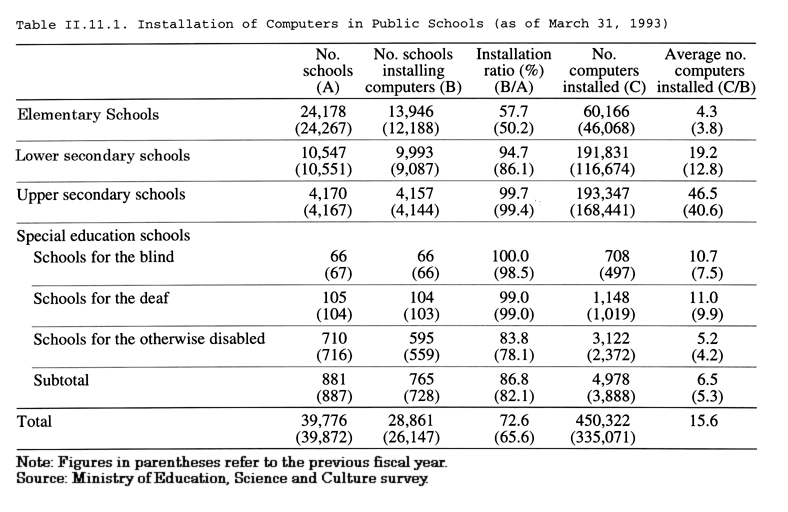| Home > Policy > White Paper, Notice, Announcement > White Paper > JAPANESE GOVERMENT POLICICIES IN EDUCATION, SCIENCE AND CULTURE 1994 > PART II Chapter 11 Section 2 1 | ||
Development of the qualities needed to deal successfully with advanced information technology will become increasingly important for the children of today, who in the future must live as independent workers and citizens in an information-oriented society. In the field of primary and secondary education, the Ministry of Education, Science and Culture has specified a number of requirements relating to fostering information literacy in the new Courses of Study. These include the following:
The introduction of basic studies about computers in mathematics and science and the establishment of "basic information" as a new area in the subjects of "industrial arts" and "home economics"
the establishment of new subject areas and subjects, such as "information," in the general education course; the improvement of information processing education in the industrial and commercial courses; and the introduction of information-related subjects in other vocational courses (agriculture, fisheries, home economics, and nursing)
The appropriate utilization of computers and other equipment in instruction in all courses
The following measures are being implemented to ensure the efficient realization of these aims and to achieve further progress in the enhancement of education to keep pace with the shift to an information-oriented society.
>From fiscal 1990 to fiscal 1994 the Ministry of Education, Science and Culture provided educational computer installation subsidies to support the systematic introduction of educational computers in all public elementary schools, lower secondary schools, and upper secondary schools (general education course) and all public special education schools throughout Japan. (The installation of computers in the general education course of upper secondary schools was completed in fiscal 1991.) Computers are also being systematically installed in the vocational course of public upper secondary schools ( Table II.11.1 ). In fiscal 1994 new targets were introduced, calling for the installation of educational computers at the rates of 22 per school (allowing the use of one computer for every two children in a class) in elementary schools, 42 (one per student) in lower secondary schools, 8 (one per student) in special education schools, and 42 (one per student) in upper secondary schools (general education course). These targets are to be achieved over a period of approximately six years, and the local allocation tax is being utilized to provide the necessary funding.
The Ministry also provides subsidies for large-scale remodeling projects for the conversion of surplus classrooms and other facilities into computer rooms and for the installation of computer equipment in conjunction with such projects. In addition, the standard area for school building subsidies has been increased for reconstruction projects designed to provide computer rooms and other spaces in order to cope with the shift to an information-oriented society in elementary schools and lower and upper secondary schools.

The Ministry of Education, Science and Culture is implementing a number of measures with the aim of enhancing education in areas that contribute to the development of students' information literacy through the improvement of teachers' teaching skills. First, training courses are being provided for teachers, including those in charge of information processing education, such as upper secondary school teachers in information-related courses concerning industry and commerce and in vocational subject areas other than industry and commerce and lower secondary school teachers of industrial arts. Second, training courses are being organized for providers of information education guidance, including mathematics and science teachers in lower and upper secondary schools and mathematics and science supervisors in prefectural boards of education. Third, information processing technicians are being employed to provide training for teachers and to improve their teaching skills. Under this program, which began in fiscal 1994, information processing technicians and other computer experts are retained as part-time teachers providing specialized advice and technical guidance. The local allocation tax is being utilized to fund the program.
The training of information technicians in upper secondary schools is being carried out mainly in information technology courses and information processing courses. Innovative subjects are being established with the aim of equipping students to cope with the rapid shift to an information-oriented society ( Table II.11.2 ).

| Back to Top | MEXT HOME |